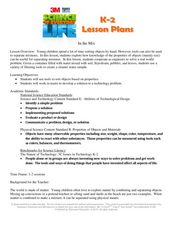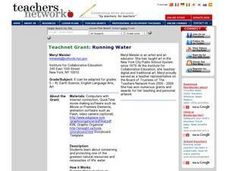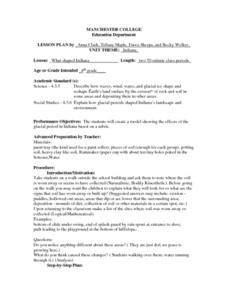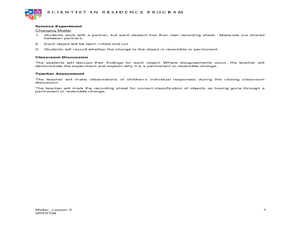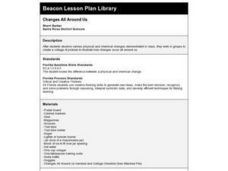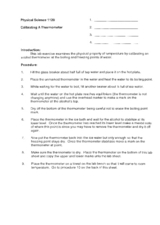Curated OER
Properties of Water with a Splash of Color
Students explore the properties of water. In this cross curriculum art and physical science activity, students experiment with a variety of materials to demonstrate the cohesive forces and adhesion of water. Students create a water color...
Curated OER
The Open Ocean, What is it and How Does it Change?
Students investigate the ocean environment. In this ocean lesson plan, students discover the physical properties of the ocean. Over two days, students work in small groups investigating ocean maps and creating water currents.
Curated OER
Earth's Land and Water
Learners describe physical characteristics of bodies of water and landforms. In this land and water lesson plan, students model land and water with modeling clay and also discuss why people live near bodies of water.
Curated OER
Water Snails
Students study water snails. In this water snails lesson, students research the habitats of water snails. After conducting research, students investigate water snails in their habitats and generate scientific observations.
Curated OER
In the Mix
Young scholars construct a water filter. In this engineering lesson, students discover how to construct a water filtration system. Young scholars work in groups to sort tools by their properties. Students analyze and construct a water...
Curated OER
Fire Triangle in the Forest
Students investigate the physical properties of fire by creating storyboards. In this elements lesson, students view a video clip of forest fires and identify the cause. Students create large storyboards defining the three...
Curated OER
Transportation
Engage in an 8-day study of different modes of transportation. Your students explore the concept of location and define the physical characteristics of places, such as, land forms, bodies of water, natural resources, and weather.
Curated OER
Running Water
Sixth graders create products that feature the importance of water conservation. In this environmental stewardship lesson, 6th graders explore the water cycle and conduct on water usage. Students also research water pollution and...
Curated OER
Factors That Shaped Indiana
Fourth graders construct a model of Indiana which displays the effects of the glacial period on the state's physical structure. Students work in groups to plan and execute their model based on an established rubric.
Curated OER
Physical Changes to Matter
Pupils explore matter by conducting an in-class experiment. They experiment with water's various forms by melting and freezing water, identifying its new shape. These observations are recorded to supplement later discussion. They also...
Curated OER
Praire Biome Models
Fifth graders, in groups, list the physical characteristics of a biome and think of ways in which animals might have to adapt to live there and make a biome mobile ball that show the different types of habitats that shape the praire biome.
Curated OER
Rocks and Minerals
Review the difference between rocks and minerals using this resource. Learners identify and investigate the physical properties of these objects. They create a Venn diagram to compare and contrast types of rocks. This is a motivating way...
Curated OER
It's not just pretty - it's a survival method!
First graders write explanations for why certain animals can only live in certain environments. In this animal survival lesson plan, 1st graders take pictures of animals and place them into the right environment after a lesson on the...
Curated OER
Be a Watershed - Create a Living River
Students investigate water ways by conducting an experiment with classmates. In this natural resources lesson, students define a watershed and identify where large ones are located within the United States. Students utilize...
Curated OER
The Three States of Matter
Students explore the three states of matter. In this physics lesson, students are shown examples of solids, liquids, and gases. Students make cookies and identify the three states of matter during the baking process.
Curated OER
Changes All Around Us
Sixth graders, in groups, observe the difference between physical and chemical changes and create a collage of pictures to show the difference.
Curated OER
Naked to the Eye
Sixth graders study microorganisms. In this microorganism lesson, 6th graders explore the form and function of these organisms. Students use magnification during experiments on bread.
Curated OER
Calibrating a Thermometer
Students calibrate an alcohol thermometer using the boiling and freezing point of water. In this physical science instructional activity, students explain what happens to boiling point of water as altitude increases. They calculate their...
Curated OER
Inter-State Matters
Students explore the six phase transitions between gases, liquids and solids for a variety of elements. Each group of students focuses on a different element, investigating its physical properties during each of the six phase transitions.
Curated OER
Thermo and Fluid Dynamics of a Homemade "Lava Lamp"
Students construct their own lava lamp using simple substances. In this physics lesson, students explain how difference in density causes convection. They solve for forces and buoyancy using mathematical equations.
Curated OER
Ice Floats
Students explore the changing density of water. In this physics lesson, students investigate how an object's density determines whether it will float or sink in water. They explain why this unique property of is important to living things.
Curated OER
Ready, Set, Let's Dough! It's a Matter of System
Students explore physical sciences by participating in a class experiment. In this matter lesson, students identify the three forms of matter and their physical differences. Students utilize cookie dough to create a play dough like...
Curated OER
What's The Scoop?
Students explore the properties of matter. In this cross curriculum three states of matter science lesson, students listen to the poem "Eighteen Flavors" by Shel Silverstein, and predict what will happen if listed ingredients are...
Curated OER
The Wetlands
Fourth graders learn what a wetland is, where they can be found, and what types of plants, animals and characteristic are associated with the wetlands. They also participate in an activity to explore and enhance their knowledge of...




